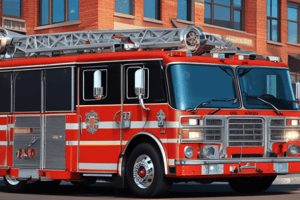Podcast
Questions and Answers
Explain the five-point size-up system used by Fire Commanders.
Explain the five-point size-up system used by Fire Commanders.
The five-point size-up system includes gathering facts, predicting probabilities, assessing resources and capabilities, analyzing the situation, and making decisions and plans of operation.
What are the two command options for Fire Commanders in cases where strong, stationary command is necessary?
What are the two command options for Fire Commanders in cases where strong, stationary command is necessary?
The Fire Commander should remain in the Forward Command Post until the incident is terminated or command is transferred, or declare either Investigative Mode or Fast Attack Mode.
What is the purpose of an Incident Action Plan (IAP)?
What is the purpose of an Incident Action Plan (IAP)?
An Incident Action Plan (IAP) is an organized, well-thought-out course of events developed to address all phases of incident control within a specific time frame, aiming to control and stabilize the incident as soon as possible.
When can the Fire Commander declare Investigative Mode or Fast Attack Mode?
When can the Fire Commander declare Investigative Mode or Fast Attack Mode?
What is the purpose of the Operating Instruction for Fire Incident Command?
What is the purpose of the Operating Instruction for Fire Incident Command?
How does the Operating Instruction define Command within structures during different stages of the incident?
How does the Operating Instruction define Command within structures during different stages of the incident?
What is the responsibility of the Fire Commander according to the Operating Instruction?
What is the responsibility of the Fire Commander according to the Operating Instruction?
How does the Operating Instruction enable clear command and control measures, integration, coordination, and communication among involved organizations?
How does the Operating Instruction enable clear command and control measures, integration, coordination, and communication among involved organizations?
What are the specific steps for planning small incidents?
What are the specific steps for planning small incidents?
What is the responsibility of the Fire Commander in relation to IMS-201 for small incidents?
What is the responsibility of the Fire Commander in relation to IMS-201 for small incidents?
When is a written Incident Action Plan (IAP) developed and by whom?
When is a written Incident Action Plan (IAP) developed and by whom?
Under what circumstances does the decision to request support from the IMT/IST occur?
Under what circumstances does the decision to request support from the IMT/IST occur?
Explain the priorities of the incident command in a fire incident.
Explain the priorities of the incident command in a fire incident.
What are the responsibilities of the Fire Commander in developing an on-scene incident structure?
What are the responsibilities of the Fire Commander in developing an on-scene incident structure?
What is the primary duty of the Fire Commander in terms of risk management?
What is the primary duty of the Fire Commander in terms of risk management?
What is the role of the Authority Having Jurisdiction (AHJ) in the fire incident command organization?
What is the role of the Authority Having Jurisdiction (AHJ) in the fire incident command organization?
Explain the role and responsibilities of the Fire Commander within the Fire Incident Command structure.
Explain the role and responsibilities of the Fire Commander within the Fire Incident Command structure.
What is Unified Command and how does it function in incidents involving multiple jurisdictions or organizations?
What is Unified Command and how does it function in incidents involving multiple jurisdictions or organizations?
Under what circumstances might a more senior officer elect to have a subordinate continue the role of Fire Commander?
Under what circumstances might a more senior officer elect to have a subordinate continue the role of Fire Commander?
What are the key elements of the Fire Command Team, and why are they crucial in managing dynamic and intense incident scenes?
What are the key elements of the Fire Command Team, and why are they crucial in managing dynamic and intense incident scenes?
Flashcards are hidden until you start studying
Study Notes
Fire Incident Command Structure and Procedures
- In the event of an incident, the transfer of command should not occur to an officer who is not on the scene, to prevent compromising incident management.
- The actual transfer of command is regulated by a specific procedure, involving communication between the officer assuming command and the person being relieved.
- The arrival of a more senior officer at the incident scene does not automatically transfer command; it only transfers when the process has been completed.
- A more senior officer may elect to have a subordinate continue the role of Fire Commander, depending on the situation and progress of the incident.
- When responding to incidents with multiple jurisdictions or organizations, Unified Command can be applied to manage the response under an integrated command structure with aligned objectives.
- Under Unified Command, each member is responsible for keeping other members informed, and there is no single "commander."
- The organizational structure of the Fire Incident Command includes distinct titles for each element, such as Branch Director, On-Scene Commander, Fire Commander, Division and Group Commander, Sector Commander, and others.
- A Fire Command Team, comprising the Fire Commander, Support Officer, and Safety Officer, is an organizational response to rapidly bring a significant incident under control.
- The primary players in the Fire Command Team are crucial for providing enough command and control to handle dynamic and intense incident scenes.
- The Station Commander should assume command of the incident by virtue of rank and seniority when arriving at the scene at the same time as the 1st Alarm assignment.
- The transfer of command should be regulated by a specific procedure, with face-to-face communication being the preferred method.
- The more senior Officer must determine if the Fire Commander is completely aware of the position and function of operating appliances and the general situational status.
Studying That Suits You
Use AI to generate personalized quizzes and flashcards to suit your learning preferences.



